Samuel Kaski
Department of Computer Science, Aalto University, Department of Computer Science, University of Manchester
Efficient Autoregressive Inference for Transformer Probabilistic Models
Oct 10, 2025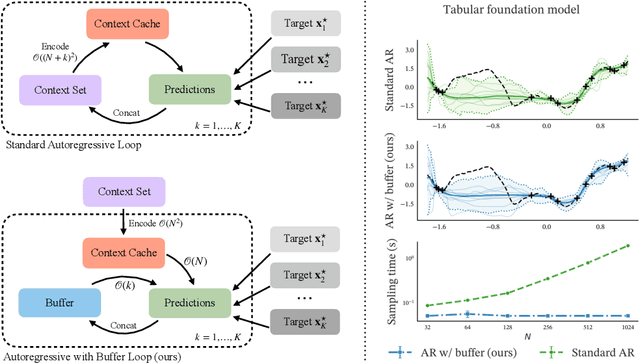

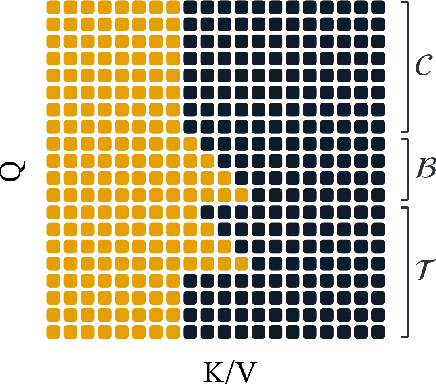

Abstract:Transformer-based models for amortized probabilistic inference, such as neural processes, prior-fitted networks, and tabular foundation models, excel at single-pass marginal prediction. However, many real-world applications, from signal interpolation to multi-column tabular predictions, require coherent joint distributions that capture dependencies between predictions. While purely autoregressive architectures efficiently generate such distributions, they sacrifice the flexible set-conditioning that makes these models powerful for meta-learning. Conversely, the standard approach to obtain joint distributions from set-based models requires expensive re-encoding of the entire augmented conditioning set at each autoregressive step. We introduce a causal autoregressive buffer that preserves the advantages of both paradigms. Our approach decouples context encoding from updating the conditioning set. The model processes the context once and caches it. A dynamic buffer then captures target dependencies: as targets are incorporated, they enter the buffer and attend to both the cached context and previously buffered targets. This enables efficient batched autoregressive generation and one-pass joint log-likelihood evaluation. A unified training strategy allows seamless integration of set-based and autoregressive modes at minimal additional cost. Across synthetic functions, EEG signals, cognitive models, and tabular data, our method matches predictive accuracy of strong baselines while delivering up to 20 times faster joint sampling. Our approach combines the efficiency of autoregressive generative models with the representational power of set-based conditioning, making joint prediction practical for transformer-based probabilistic models.
An Interactive Framework for Finding the Optimal Trade-off in Differential Privacy
Sep 04, 2025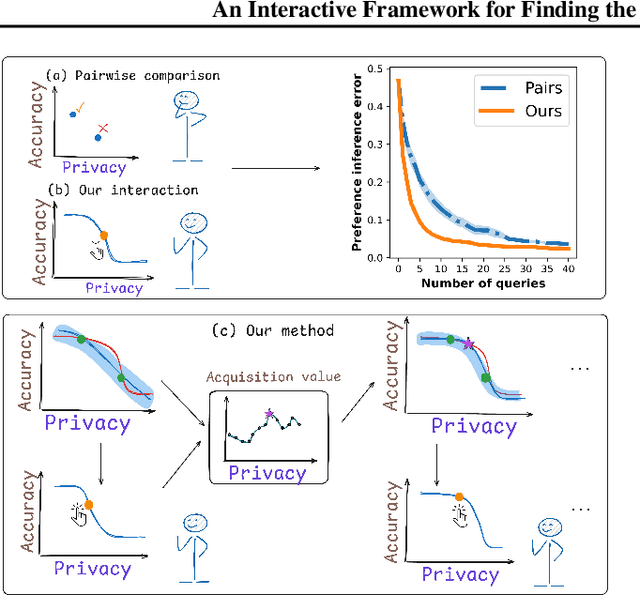

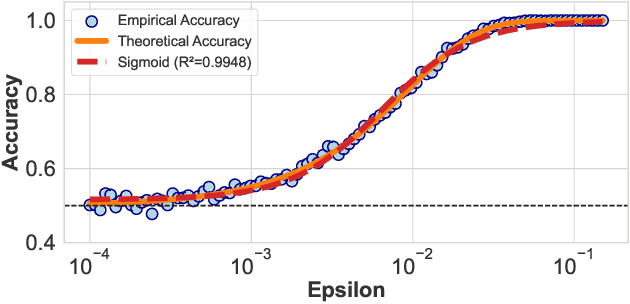
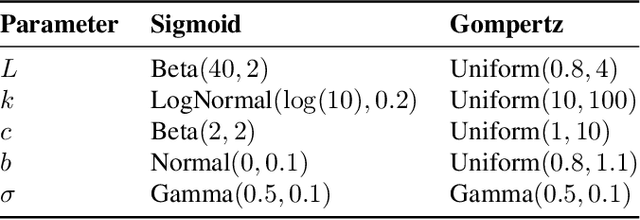
Abstract:Differential privacy (DP) is the standard for privacy-preserving analysis, and introduces a fundamental trade-off between privacy guarantees and model performance. Selecting the optimal balance is a critical challenge that can be framed as a multi-objective optimization (MOO) problem where one first discovers the set of optimal trade-offs (the Pareto front) and then learns a decision-maker's preference over them. While a rich body of work on interactive MOO exists, the standard approach -- modeling the objective functions with generic surrogates and learning preferences from simple pairwise feedback -- is inefficient for DP because it fails to leverage the problem's unique structure: a point on the Pareto front can be generated directly by maximizing accuracy for a fixed privacy level. Motivated by this property, we first derive the shape of the trade-off theoretically, which allows us to model the Pareto front directly and efficiently. To address inefficiency in preference learning, we replace pairwise comparisons with a more informative interaction. In particular, we present the user with hypothetical trade-off curves and ask them to pick their preferred trade-off. Our experiments on differentially private logistic regression and deep transfer learning across six real-world datasets show that our method converges to the optimal privacy-accuracy trade-off with significantly less computational cost and user interaction than baselines.
Shapley Machine: A Game-Theoretic Framework for N-Agent Ad Hoc Teamwork
Jun 12, 2025Abstract:Open multi-agent systems are increasingly important in modeling real-world applications, such as smart grids, swarm robotics, etc. In this paper, we aim to investigate a recently proposed problem for open multi-agent systems, referred to as n-agent ad hoc teamwork (NAHT), where only a number of agents are controlled. Existing methods tend to be based on heuristic design and consequently lack theoretical rigor and ambiguous credit assignment among agents. To address these limitations, we model and solve NAHT through the lens of cooperative game theory. More specifically, we first model an open multi-agent system, characterized by its value, as an instance situated in a space of cooperative games, generated by a set of basis games. We then extend this space, along with the state space, to accommodate dynamic scenarios, thereby characterizing NAHT. Exploiting the justifiable assumption that basis game values correspond to a sequence of n-step returns with different horizons, we represent the state values for NAHT in a form similar to $\lambda$-returns. Furthermore, we derive Shapley values to allocate state values to the controlled agents, as credits for their contributions to the ad hoc team. Different from the conventional approach to shaping Shapley values in an explicit form, we shape Shapley values by fulfilling the three axioms uniquely describing them, well defined on the extended game space describing NAHT. To estimate Shapley values in dynamic scenarios, we propose a TD($\lambda$)-like algorithm. The resulting reinforcement learning (RL) algorithm is referred to as Shapley Machine. To our best knowledge, this is the first time that the concepts from cooperative game theory are directly related to RL concepts. In experiments, we demonstrate the effectiveness of Shapley Machine and verify reasonableness of our theory.
Generalization Analysis for Bayesian Optimal Experiment Design under Model Misspecification
Jun 09, 2025Abstract:In many settings in science and industry, such as drug discovery and clinical trials, a central challenge is designing experiments under time and budget constraints. Bayesian Optimal Experimental Design (BOED) is a paradigm to pick maximally informative designs that has been increasingly applied to such problems. During training, BOED selects inputs according to a pre-determined acquisition criterion. During testing, the model learned during training encounters a naturally occurring distribution of test samples. This leads to an instance of covariate shift, where the train and test samples are drawn from different distributions. Prior work has shown that in the presence of model misspecification, covariate shift amplifies generalization error. Our first contribution is to provide a mathematical decomposition of generalization error that reveals key contributors to generalization error in the presence of model misspecification. We show that generalization error under misspecification is the result of, in addition to covariate shift, a phenomenon we term error (de-)amplification which has not been identified or studied in prior work. Our second contribution is to provide a detailed empirical analysis to show that methods that result in representative and de-amplifying training data increase generalization performance. Our third contribution is to develop a novel acquisition function that mitigates the effects of model misspecification by including a term for representativeness and implicitly inducing de-amplification. Our experimental results demonstrate that our method outperforms traditional BOED in the presence of misspecification.
ALINE: Joint Amortization for Bayesian Inference and Active Data Acquisition
Jun 08, 2025Abstract:Many critical applications, from autonomous scientific discovery to personalized medicine, demand systems that can both strategically acquire the most informative data and instantaneously perform inference based upon it. While amortized methods for Bayesian inference and experimental design offer part of the solution, neither approach is optimal in the most general and challenging task, where new data needs to be collected for instant inference. To tackle this issue, we introduce the Amortized Active Learning and Inference Engine (ALINE), a unified framework for amortized Bayesian inference and active data acquisition. ALINE leverages a transformer architecture trained via reinforcement learning with a reward based on self-estimated information gain provided by its own integrated inference component. This allows it to strategically query informative data points while simultaneously refining its predictions. Moreover, ALINE can selectively direct its querying strategy towards specific subsets of model parameters or designated predictive tasks, optimizing for posterior estimation, data prediction, or a mixture thereof. Empirical results on regression-based active learning, classical Bayesian experimental design benchmarks, and a psychometric model with selectively targeted parameters demonstrate that ALINE delivers both instant and accurate inference along with efficient selection of informative points.
Epistemic Errors of Imperfect Multitask Learners When Distributions Shift
May 29, 2025Abstract:When data are noisy, a statistical learner's goal is to resolve epistemic uncertainty about the data it will encounter at test-time, i.e., to identify the distribution of test (target) data. Many real-world learning settings introduce sources of epistemic uncertainty that can not be resolved on the basis of training (source) data alone: The source data may arise from multiple tasks (multitask learning), the target data may differ systematically from the source data tasks (distribution shift), and/or the learner may not arrive at an accurate characterization of the source data (imperfect learning). We introduce a principled definition of epistemic error, and provide a generic, decompositional epistemic error bound. Our error bound is the first to (i) consider epistemic error specifically, (ii) accommodate all the sources of epistemic uncertainty above, and (iii) separately attribute the error to each of multiple aspects of the learning procedure and environment. As corollaries of the generic result, we provide (i) epistemic error bounds specialized to the settings of Bayesian transfer learning and distribution shift within $\epsilon$-neighborhoods, and (ii) a set of corresponding generalization bounds. Finally, we provide a novel definition of negative transfer, and validate its insights in a synthetic experimental setting.
Robust and Computation-Aware Gaussian Processes
May 27, 2025Abstract:Gaussian processes (GPs) are widely used for regression and optimization tasks such as Bayesian optimization (BO) due to their expressiveness and principled uncertainty estimates. However, in settings with large datasets corrupted by outliers, standard GPs and their sparse approximations struggle with computational tractability and robustness. We introduce Robust Computation-aware Gaussian Process (RCaGP), a novel GP model that jointly addresses these challenges by combining a principled treatment of approximation-induced uncertainty with robust generalized Bayesian updating. The key insight is that robustness and approximation-awareness are not orthogonal but intertwined: approximations can exacerbate the impact of outliers, and mitigating one without the other is insufficient. Unlike previous work that focuses narrowly on either robustness or approximation quality, RCaGP combines both in a principled and scalable framework, thus effectively managing both outliers and computational uncertainties introduced by approximations such as low-rank matrix multiplications. Our model ensures more conservative and reliable uncertainty estimates, a property we rigorously demonstrate. Additionally, we establish a robustness property and show that the mean function is key to preserving it, motivating a tailored model selection scheme for robust mean functions. Empirical results confirm that solving these challenges jointly leads to superior performance across both clean and outlier-contaminated settings, both on regression and high-throughput Bayesian optimization benchmarks.
PABBO: Preferential Amortized Black-Box Optimization
Mar 02, 2025Abstract:Preferential Bayesian Optimization (PBO) is a sample-efficient method to learn latent user utilities from preferential feedback over a pair of designs. It relies on a statistical surrogate model for the latent function, usually a Gaussian process, and an acquisition strategy to select the next candidate pair to get user feedback on. Due to the non-conjugacy of the associated likelihood, every PBO step requires a significant amount of computations with various approximate inference techniques. This computational overhead is incompatible with the way humans interact with computers, hindering the use of PBO in real-world cases. Building on the recent advances of amortized BO, we propose to circumvent this issue by fully amortizing PBO, meta-learning both the surrogate and the acquisition function. Our method comprises a novel transformer neural process architecture, trained using reinforcement learning and tailored auxiliary losses. On a benchmark composed of synthetic and real-world datasets, our method is several orders of magnitude faster than the usual Gaussian process-based strategies and often outperforms them in accuracy.
Memento No More: Coaching AI Agents to Master Multiple Tasks via Hints Internalization
Feb 03, 2025Abstract:As the general capabilities of artificial intelligence (AI) agents continue to evolve, their ability to learn to master multiple complex tasks through experience remains a key challenge. Current LLM agents, particularly those based on proprietary language models, typically rely on prompts to incorporate knowledge about the target tasks. This approach does not allow the agent to internalize this information and instead relies on ever-expanding prompts to sustain its functionality in diverse scenarios. This resembles a system of notes used by a person affected by anterograde amnesia, the inability to form new memories. In this paper, we propose a novel method to train AI agents to incorporate knowledge and skills for multiple tasks without the need for either cumbersome note systems or prior high-quality demonstration data. Our approach employs an iterative process where the agent collects new experiences, receives corrective feedback from humans in the form of hints, and integrates this feedback into its weights via a context distillation training procedure. We demonstrate the efficacy of our approach by implementing it in a Llama-3-based agent which, after only a few rounds of feedback, outperforms advanced models GPT-4o and DeepSeek-V3 in a taskset requiring correct sequencing of information retrieval, tool use, and question answering.
Towards modeling evolving longitudinal health trajectories with a transformer-based deep learning model
Dec 12, 2024Abstract:Health registers contain rich information about individuals' health histories. Here our interest lies in understanding how individuals' health trajectories evolve in a nationwide longitudinal dataset with coded features, such as clinical codes, procedures, and drug purchases. We introduce a straightforward approach for training a Transformer-based deep learning model in a way that lets us analyze how individuals' trajectories change over time. This is achieved by modifying the training objective and by applying a causal attention mask. We focus here on a general task of predicting the onset of a range of common diseases in a given future forecast interval. However, instead of providing a single prediction about diagnoses that could occur in this forecast interval, our approach enable the model to provide continuous predictions at every time point up until, and conditioned on, the time of the forecast period. We find that this model performs comparably to other models, including a bi-directional transformer model, in terms of basic prediction performance while at the same time offering promising trajectory modeling properties. We explore a couple of ways to use this model for analyzing health trajectories and aiding in early detection of events that forecast possible later disease onsets. We hypothesize that this method may be helpful in continuous monitoring of peoples' health trajectories and enabling interventions in ongoing health trajectories, as well as being useful in retrospective analyses.
 Add to Chrome
Add to Chrome Add to Firefox
Add to Firefox Add to Edge
Add to Edge